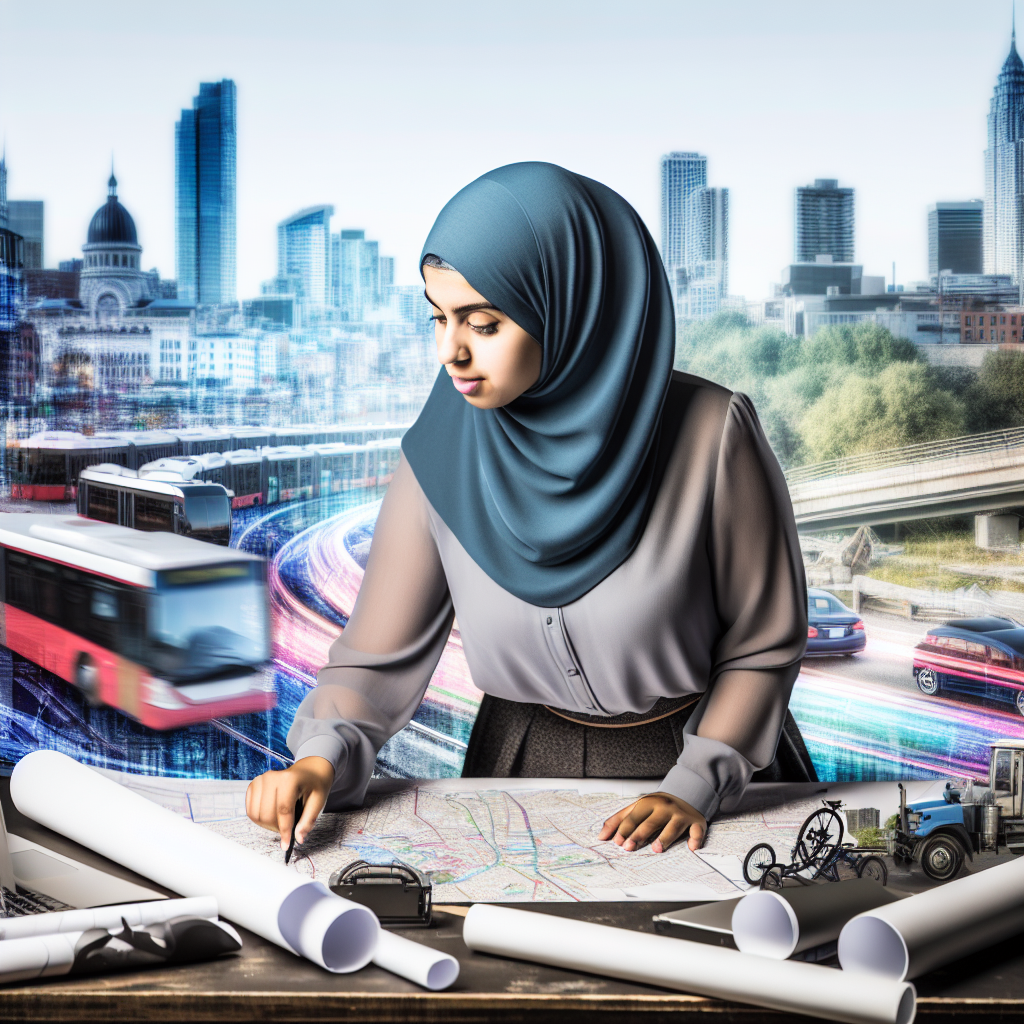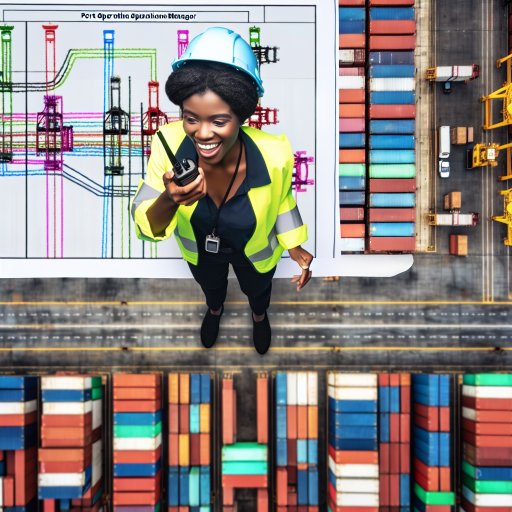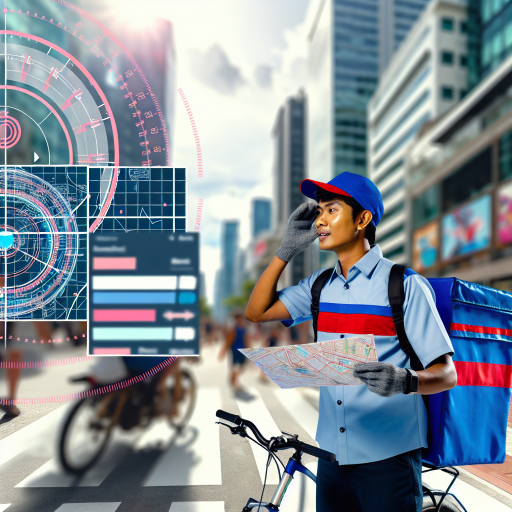Introduction:
Urban transportation planning plays a crucial role in ensuring efficient movement within cities.
It helps in reducing traffic congestion, improving air quality, and enhancing overall quality of life.
With the advancements in technology, urban transportation planning has seen a significant transformation.
Various technologies such as smart traffic lights, GPS tracking systems, and ride-sharing apps are revolutionizing this field.
These technologies are enabling cities to optimize traffic flow, reduce commute times, and promote sustainable modes of transportation.
Furthermore, data analytics and predictive modeling tools are being used to make informed decisions in transportation planning.
This data-driven approach allows urban planners to identify patterns, make predictions, and implement effective strategies.
Additionally, electric vehicles and self-driving cars are changing the way people commute and are reshaping urban transportation systems.
Overall, these technologies are reshaping urban transportation planning and paving the way for smarter, more efficient, and sustainable cities.
Use of Big Data in Transportation Planning:
Big data plays a crucial role in shaping the future of urban transportation planning.
The collection and analysis of vast amounts of data have revolutionized the way cities approach transportation infrastructure.
- Collecting Big Data: Data is collected from various sources such as sensors, GPS devices, traffic cameras, and mobile apps.
- Analyzing Big Data: Advanced analytics tools are used to process the collected data and extract valuable insights.
- Improving Transportation Efficiency: By harnessing the power of big data, city planners can make data-driven decisions to reduce congestion, improve traffic flow, and enhance the overall efficiency of public transportation systems.
- Enhancing Safety: Big data is also used to enhance safety on the roads.
Integration of Artificial Intelligence
Artificial Intelligence (AI) is playing a crucial role in transforming urban transportation planning.
It enhances efficiency and reduces congestion on roads.
Let’s explore how AI is being used to optimize traffic flow and improve overall transportation systems in cities worldwide.
AI in Traffic Flow Optimization
- AI algorithms analyze real-time traffic data to predict congestion patterns and adjust traffic signals accordingly.
- Optimizing traffic flow reduces travel times, fuel consumption, and emissions, leading to a more sustainable urban environment.
- Smart traffic lights equipped with AI technology can adapt to traffic conditions and prioritize high-traffic routes during peak hours.
- AI-driven traffic management systems can dynamically reroute vehicles to less congested roads, minimizing traffic jams and improving overall traffic flow.
Case Studies of Cities Implementing AI
- Singapore: The city-state of Singapore has successfully implemented AI-powered traffic management systems to reduce congestion and enhance public transportation efficiency.
- Los Angeles: The city of Los Angeles has utilized AI algorithms to optimize traffic signal timings, resulting in reduced travel times and improved air quality.
- Barcelona: Barcelona has integrated AI technology into its transportation planning to enhance mobility services and reduce traffic congestion in the city.
- London: London has deployed AI-powered traffic prediction models to provide real-time traffic updates and optimize traffic flow on its busy roads.
The integration of Artificial Intelligence in urban transportation planning is revolutionizing how cities address traffic congestion and improve transportation efficiency.
With AI’s ability to analyze vast amounts of data and make data-driven decisions, cities can create smarter, more sustainable transportation systems for the future.
Uncover the Details: Essential Gear and Equipment for Seamen
Implementation of Autonomous Vehicles
Autonomous vehicles, also known as self-driving cars, are revolutionizing urban transportation planning.
These vehicles have the potential to transform how people and goods move around cities.
They offer numerous benefits as well as pose several challenges.
Transform Your Career Today
Unlock a personalized career strategy that drives real results. Get tailored advice and a roadmap designed just for you.
Start NowImpact of Autonomous Vehicles on Urban Transportation
- Reduce traffic congestion: Autonomous vehicles can communicate with each other to optimize traffic flow and reduce bottlenecks.
- Enhance road safety: Self-driving cars have the potential to significantly reduce accidents caused by human error.
- Improve transportation accessibility: Autonomous vehicles can provide transportation options for people with limited mobility.
- Enhance public transportation: Self-driving cars can complement existing public transportation systems, offering first and last-mile solutions.
Overall, the integration of autonomous vehicles into urban transportation can lead to more efficient, safer, and accessible mobility options for residents.
Challenges and Benefits of Integrating Self-Driving Cars
- Challenges:
- Lack of regulations: Current laws and regulations may not be sufficient to address the complexities of autonomous vehicles.
- Security concerns: Self-driving cars are vulnerable to cybersecurity threats, posing risks to passenger safety and data privacy.
- Transition period: The transition to autonomous vehicles may require significant infrastructure upgrades and changes in urban planning.
- Job displacement: The adoption of self-driving cars may lead to job losses for drivers and workers in related industries.
- Benefits:
- Efficiency: Autonomous vehicles can optimize routes and reduce travel times, improving overall transportation efficiency.
- Environmental impact: Self-driving cars can help reduce emissions and contribute to a more sustainable urban environment.
- Cost savings: Autonomous vehicles could lower transportation costs for individuals and businesses through shared mobility services.
- Improved mobility: Self-driving cars can provide transportation options for underserved communities and improve access to essential services.
Despite the challenges, the benefits of integrating self-driving cars into urban transportation networks are substantial.
This integration paves the way for a more connected and efficient future for cities around the world.
Learn More: Top Maritime Pilot Schools and Academies in the United States
Development of Smart Infrastructure:
In today’s rapidly evolving urban landscape, smart infrastructure technologies have revolutionized the way cities manage their transportation systems.
These technologies encompass a wide range of sensors, cameras, and IoT devices that are embedded in the urban environment to gather real-time data on traffic patterns, pedestrian movement, and environmental conditions.
Smart sensors are installed on roads, traffic lights, and even on vehicles themselves to collect data on vehicle speed, density, and behavior.
These sensors can detect changes in traffic flow, congestion, and accidents, allowing urban planners to make data-driven decisions in real-time.
IoT devices, on the other hand, are interconnected through the internet to create a seamless network of data exchange.
These devices can communicate with each other, sharing information on traffic conditions, weather forecasts, and road maintenance needs.
By leveraging IoT technology, cities can optimize their transportation systems, reducing congestion and improving overall efficiency.
How these technologies are used to monitor and manage traffic flow:
The data collected from smart infrastructure technologies is analyzed using advanced algorithms and artificial intelligence to optimize traffic flow and improve urban transportation planning.
By monitoring real-time traffic conditions, cities can implement adaptive traffic signal systems that respond to changing congestion levels.
For example, sensors can detect a sudden increase in traffic volume on a particular road and adjust traffic light timings to prioritize the flow of vehicles in that direction.
This dynamic approach to traffic management helps to alleviate congestion and reduce travel times for commuters.
Moreover, smart infrastructure technologies enable cities to identify traffic bottlenecks, accident-prone areas, and high-pedestrian zones.
By strategically placing sensors and IoT devices in these locations, urban planners can proactively address traffic safety concerns and streamline transportation infrastructure.
The development of smart infrastructure technologies has significantly transformed urban transportation planning by providing real-time data, enhancing traffic management strategies, and improving overall city livability.
As cities continue to grow and evolve, the integration of these technologies will be crucial in creating sustainable and efficient transportation systems for the future.
Showcase Your Business Today
Reach thousands of readers actively exploring professional services. Publish your business profile and grow your audience now.
Publish NowDelve into the Subject: Understanding Material Handling Processes
Rise of Ride-sharing Services
Ride-sharing services like Uber and Lyft have experienced exponential growth in urban areas.
These services offer convenient, on-demand transportation options that have become increasingly popular.
Users can simply request a ride through an app on their smartphones, making it easy to get around.
Ride-sharing has provided a more flexible and cost-effective alternative to traditional taxi services.
It has also contributed to reducing the number of private vehicles on the road, easing traffic congestion.
Micro Mobility Options
Micro mobility options, such as e-scooters, are also changing urban transportation habits.
These compact, electric-powered scooters offer a convenient and environmentally-friendly mode of transportation.
They can be rented on a short-term basis through an app, making them accessible for short trips.
E-scooters are particularly popular for first and last-mile connectivity in urban areas.
They help reduce the reliance on cars for short distances, reducing congestion and emissions.
The growth of ride-sharing services and micro mobility options is revolutionizing urban transportation planning.
These options provide new ways for people to get around cities more efficiently and sustainably.
Find Out More: Material Handler’s Role in Logistics Strategy

Environmental Considerations in Transportation Planning:
Urban transportation is a major contributor to carbon emissions.
This leads to air pollution and climate change.
As cities continue to grow, the need for sustainable transportation solutions becomes crucial.
By reducing carbon emissions in urban transportation, cities can mitigate the negative impacts on the environment and public health.
Importance of Reducing Carbon Emissions in Urban Transportation
Electric vehicles (EVs) have emerged as a promising solution to reduce carbon emissions in urban transportation.
City planners are increasingly incorporating EV infrastructure and policies into their transportation planning efforts.
The widespread adoption of EVs can significantly decrease the reliance on fossil fuels.
It can also lower greenhouse gas emissions.
Incorporating technologies like EVs into transportation planning efforts requires a strategic approach.
City officials need to assess the current transportation system.
They should identify areas for improvement.
Then, implement policies that support the adoption of electric vehicles.
This may include building charging stations.
It could also involve incentivizing residents to switch to EVs.
Integrating EVs into public transportation systems is another important step.
By integrating electric vehicles into urban transportation planning, cities can reduce carbon emissions.
They can also improve air quality and create a more sustainable urban environment.
As technology advances, it is essential for cities to stay ahead of the curve.
They should leverage innovative solutions to address environmental challenges in transportation planning.
Public Participation and Community Engagement:
When it comes to urban transportation planning, public participation and community engagement play a crucial role in ensuring that the needs and preferences of residents are taken into account.
Technology has revolutionized the way stakeholders are engaged and feedback is collected, making the process more inclusive and transparent.
Role of technology in engaging stakeholders and gathering feedback:
- Technology has made it easier for transportation planners to reach out to stakeholders through various online platforms.
- Social media, surveys, and interactive mapping tools are used to gather feedback from the community.
- Virtual town hall meetings and webinars allow residents to participate in discussions from the comfort of their homes.
- Online forums and mobile apps provide a convenient way for people to voice their opinions and concerns.
- Data analytics tools help in analyzing the feedback collected and identifying key areas of improvement.
- Augmented reality and virtual reality technologies allow residents to visualize proposed transportation projects before they are implemented.
Examples of how communities are involved in transportation planning decisions through digital platforms:
- In cities like Los Angeles, residents can use apps like LA Mobile to report potholes, broken traffic signals, and other transportation-related issues.
- The City of Boston has launched an online platform called Engage Boston where residents can participate in surveys, polls, and virtual meetings to provide input on transportation projects.
- The Transport for London (TfL) uses social media channels to communicate with the public about upcoming transportation initiatives and gather feedback on proposed plans.
- In Singapore, the MyTransport.SG app allows residents to access real-time information on public transportation services and provide feedback on their experiences.
- In New York City, the DOT’s Street Ambassador program employs volunteers to collect data on pedestrian and cyclist behaviors using mobile apps, helping shape safer streets.
- The City of Portland uses interactive maps to engage residents in the planning process for bike lanes, bus stops, and other infrastructure projects, soliciting feedback on proposed designs.
Technology has transformed the way communities are involved in transportation planning decisions.
This makes the process more democratic, inclusive, and responsive to the needs of residents.
By leveraging digital platforms and innovative tools, urban planners can ensure that transportation projects are designed with the community in mind.
Showcase Your Business Today
Reach thousands of readers actively exploring professional services. Publish your business profile and grow your audience now.
Publish NowThis leads to more sustainable and people-centric cities.
Future Trends in Urban Transportation Planning
As urban transportation planning continues to evolve, there are several future trends that are poised to further transform the field.
Staying ahead of the curve in an ever-evolving urban landscape is crucial for cities looking to create efficient and sustainable transportation systems.
Speculation on upcoming technologies that will further transform the field:
- Autonomous Vehicles: The development and deployment of autonomous vehicles are expected to revolutionize urban transportation. These self-driving cars have the potential to reduce traffic congestion and improve safety on the roads.
- Electric Vehicles: The shift towards electric vehicles is gaining momentum as cities look to reduce carbon emissions and combat climate change. With advancements in battery technology, electric vehicles are becoming more viable for everyday use.
- Hyperloop: The concept of a hyperloop system, which uses magnetic levitation technology to propel pods through vacuum tubes at high speeds, could drastically reduce travel times between cities. This futuristic mode of transportation has the potential to revolutionize intercity travel.
- Smart Infrastructure: The integration of smart infrastructure, such as sensor-equipped traffic lights and connected roadways, can help optimize traffic flow and improve overall transportation efficiency. With real-time data analytics, cities can better manage traffic patterns and reduce congestion.
- Mobility as a Service (MaaS): The rise of MaaS platforms, which offer integrated transportation services through a single digital interface, is changing the way people move around cities. By providing seamless access to various modes of transportation, MaaS aims to make urban travel more convenient and sustainable.
The importance of staying ahead of the curve in an ever-evolving urban landscape:
With urban populations growing at a rapid pace, cities need to anticipate and adapt to changing mobility needs.
By embracing new technologies and innovative solutions, urban transportation planners can create more efficient, accessible, and sustainable transportation systems that meet the needs of residents and businesses alike.
Furthermore, staying ahead of the curve in urban transportation planning allows cities to address pressing challenges such as traffic congestion, air pollution, and limited transportation options.
By investing in future-oriented strategies and technologies, cities can mitigate these challenges and create a more livable and resilient urban environment.
Future trends in urban transportation planning hold the promise of transforming how people move around cities.
By embracing new technologies and staying ahead of the curve, cities can create transportation systems that are efficient, sustainable, and responsive to the needs of their residents.
As we look towards the future, it is imperative for urban planners to continue innovating and adapting to ensure that cities remain vibrant and connected hubs of activity.
Recap of Key Points
Throughout this discussion, we have explored how technologies are revolutionizing urban transportation planning.
We highlighted the importance of data analytics, AI, and IoT in optimizing traffic flow and enhancing commuter experience.
Additionally, we touched on the significance of smart infrastructure, such as connected vehicles and autonomous shuttles, in promoting sustainable mobility solutions.
Emphasis on the Crucial Role of Technology
Technology plays a critical role in shaping the future of urban transportation planning.
It enables cities to address various challenges like traffic congestion, air pollution, and limited parking spaces.
By leveraging innovative solutions, urban planners can create more efficient transportation systems that prioritize safety, accessibility, and environmental sustainability.
As we move forward, it is essential to embrace emerging technologies to build smarter and more resilient cities for the benefit of all residents.
Additional Resources
Transforming Transportation Advisory Committee | US Department …
[E-Books for Sale]
The Big Book of 500 High-Paying Jobs in America: Unlock Your Earning Potential
$19.99 • 500 High-Paying Jobs • 330 pages
Explore 500 high-paying jobs in America and learn how to boost your career, earn more, and achieve success!
See All 500 High-Paying Jobs of this E-Book
1001 Professions Without a Degree: High-Paying American Jobs You Can Start Now
$19.99 • 1001 Professions Without a Degree • 174 pages
Discover 1001 high-paying jobs without a degree! Unlock career tips, skills, and success strategies for just $19.99!




